Samm Bennett biography
Earliest Years
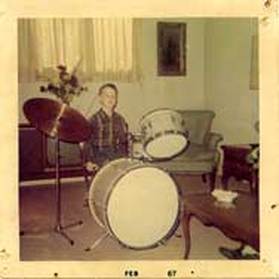
Samm Bennett was born on May 25, 1957 in Birmingham, Alabama, USA, the day that Elvis Presley's "All Shook Up" reached number one on the US charts. Some of his earliest musical recollections are the AM radio stations in the heart of the deep south, playing country and western music, or the soul and R&B stations way over on the right side (often called "the black side") of the AM dial. He also heard plenty of Motown, girl groups, some surf rock and a bit of doo-wop, which were all popular with his two older sisters. His sisters' folk guitar strumming and singing (they liked to sing Bob Dylan, Woody Guthrie and Joan Baez songs) were also very influential, and the blues was here and there in the air, of course. And on dad's record player, there was Frank Sinatra, Nat King Cole and Dean Martin. But as a very young child he was most enthralled with the Beatles (it just looked like they were having so much fun) and from around the age of six he was already saying he wanted to be a drummer, like Ringo Starr. After years of banging on the kitchen pots and pans, his father relented and bought him a starter drum kit for his 13th birthday.
photo: 1967, playing his cousin Frank's drums in Greenville SC, age 10
photo: 1967, playing his cousin Frank's drums in Greenville SC, age 10
High School Years
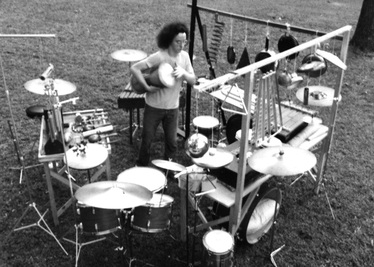
He spent his high school years playing in a few haphazardly thrown together "bands" (mostly just some guys jamming every now and then), but spent most of his time, after school, playing along to records, with the Allman Brothers or Sly and the Family Stone blasting in his headphones. Soon he was augmenting the standard drum kit with all manner of junk metal, pots and pans (a nod to his earliest sonic tools?) and miscellaneous noisemakers, and in this way his restless desire to expand his sound horizons and means of expression was already beginning to show. Shortly after graduating high school, he started performing solo concerts here and there in his native Birmingham, was a member of a couple of different bands, and also accompanied several performances by the Birmingham Creative Dance Co., led by the late Laura Knox.
photo: 1976, percussion cage, Glen Iris Park, Birmingham
photo: 1976, percussion cage, Glen Iris Park, Birmingham
Boston, 1977-1984
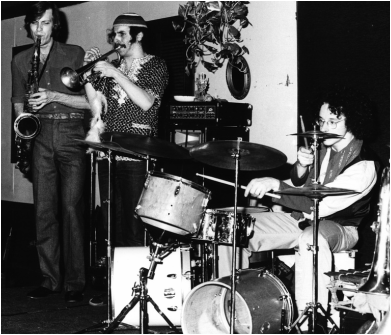
In 1977, at the age of 20, Samm moved to Boston, a town that seemed to offer broader possibilities for a young musician eager to play and grow and try new things. Though he didn't attend any college or music school, he found himself immersed in a new world of musical possibilities and friendships, and in his eight years there he did an enormous amount of playing and learning. It was there that he was first exposed to African drumming styles, mostly through attending weekly drum ensemble workshops led by Boston underground percussion legend Syd Smart. During his years there Samm played with several musicians who would go on to make names for themselves in the world of jazz and improvised music, notably guitarist Joe Morris, clarinetist Don Byron and trumpeter Frank London. Throughout his years in Boston he made frequent trips to New York City, where he took in lots of live music of all kinds, and took some drum lessons from percussion wizard Milford Graves, as well as lessons with drummers Andrew Cyrille and Barry Altschul.
photo: 1978, with Ensemble Garuda (Tom Hall and Frank London)
photo: 1978, with Ensemble Garuda (Tom Hall and Frank London)
Nigeria (1980/81)
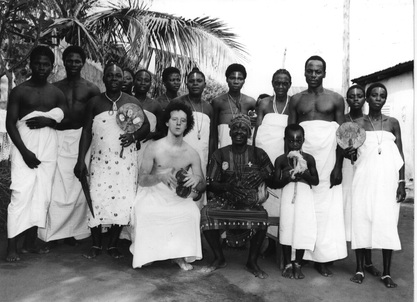
During the "Boston years", Bennett made two extended trips out of the US, both of which would prove very important to his musical development. In late 1980, he went to Nigeria, West Africa, taking a boat from Sicily to Tunis, then to Algiers, then traveling due south overland across the Sahara desert. Traveling with a friend who introduced him to a family in Benin City, Nigeria, he remained there as their guest for six months, making daily trips to the home of drum master Idemudia Izevbihen and his extended family of drummers and singers. They called themselves the Ehengbuda Cult Messengers, and played frequently in Benin City and surrounding villages for funerals, which were the social functions where traditional music was in great demand. Samm learned some drumming styles from Idemudia and his family members, performed with them at some of the all night funeral festivities, and was privileged to see firsthand, from the inside, how these traditional musicians function in their society. It was a profoundly rewarding experience.
photo: 1981, playing ighede drums in a formal portrait with idemudia and the Ehengbuda Cult Messengers
photo: 1981, playing ighede drums in a formal portrait with idemudia and the Ehengbuda Cult Messengers
Europe (1983)
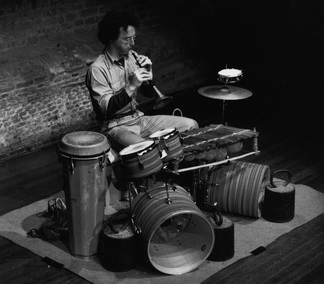
live in Delft, Holland, 1983
In 1983, following Samm's second solo concert tour in Europe, he received an offer from a music club owner in Brussels, Belgium, to stay in an available flat above the club. During the next nine months Samm resided there, and it became a period of very prolific solo performance. Up until that time, opportunities to hone his performing skills in front of live audiences had not been as numerous as he would've liked, but suddenly, in northern Europe, there were opportunities galore. So, this time period was very important in his musical and professional development. He was working then with a unique drum kit of his own devising, a sort of melodic percussion kit consisting of several drums, with careful attention to their tuning. He also used an African xylophone (balafon) in some of his concerts at that time. Though he would later move away from the somewhat "one man band" character of this instrumental grouping and performance method, this way of music making, at the time, suited him and his audiences very well. Listeners always expressed surprise that one person could generate such a complex interweaving of rhythms and textures, and more than one reviewer of the time compared his solo performances to the sound of a larger drum ensemble. During this period, Samm was hired by a Brussels music enthusiast to record his first solo album. The original producer, however, fell onto hard times and didn't start his own label, as he had planned. But, to Samm's great surprise, more than a year later, after moving to New York City, he received two copies of the LP (entitled Metafunctional) in the mail. It had wound up being released by the Igloo label in Belgium, with an inappropriate jacket that Bennett never would've approved if he'd had any say in the matter! It was an early glimpse of the unpredictable vicissitudes of the music business.
Manu Dibango!
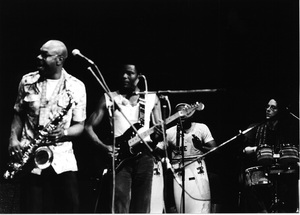
In addition to many, many concerts in towns and cities throughout Belgium and Holland, Samm also appeared at the 1983 North Sea Jazz Festival in the Hague (Holland) in a solo performance attended by some 1000 people, which was the largest crowd he'd ever played to. He also appeared on Belgian children's TV show Lollipop (!) and, after opening as a solo act for African saxophone legend Manu DiBango in Gent, DiBango invited Samm to join his band for the night, as well as the next night for their Brussels performance. Bennett's remembrances of that night in Gent can be found here.
photo: 1983, with Manu DiBango and band, Vooruit Theatre, Gent, Belgium
photo: 1983, with Manu DiBango and band, Vooruit Theatre, Gent, Belgium
New York City, 1984~1995
Bosho
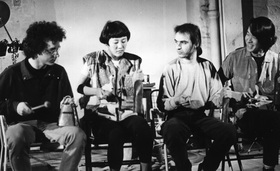
Bosho, 1985, Experimental Intermedia Foundation, NYC
Over the course of the eleven years that Samm resided in New York City (Fort Greene, Brooklyn, to be exact) he took part in musical projects and groupings too numerous to cover thoroughly here. But overall, the period is marked by his gradual shift in focus from drummer and instrumental musician to singer and songwriter. Little by little, his song work moved to the forefront of his musical activities. But we'll start with one of his earliest projects in New York, a band that he founded in 1984, called Bosho. Bosho started as a percussion trio, with members Yuval Gabay (later Yuval would drum for Soul Coughing and later still with British drum'n'bass legend Roni Size) and dancer/musician Kumiko Kimoto (now known
as Koosil-ja Hwang). They were soon joined by the immensely creative Hahn Rowe, on guitar and violin (Hahn later went on to Hugo Largo and many other interesting projects, including a duo with Samm, which we'll look at a bit later). Bosho released one LP, entitled Chop Socky. You can hear a little more of what the New York Times' Jon Pareles called their "crafty, off-center funk" here in this YouTube clip. Bosho played many, many shows in New York, and did several European tours as well. And they were once brought to Japan, to play one show, an all-nighter on a boat cruising the Japan inland sea, then flew home the next day! "Ah, but those were the reasons, and that was New York..." Samm left the band around 1991, and the group disbanded altogether around 1993.
as Koosil-ja Hwang). They were soon joined by the immensely creative Hahn Rowe, on guitar and violin (Hahn later went on to Hugo Largo and many other interesting projects, including a duo with Samm, which we'll look at a bit later). Bosho released one LP, entitled Chop Socky. You can hear a little more of what the New York Times' Jon Pareles called their "crafty, off-center funk" here in this YouTube clip. Bosho played many, many shows in New York, and did several European tours as well. And they were once brought to Japan, to play one show, an all-nighter on a boat cruising the Japan inland sea, then flew home the next day! "Ah, but those were the reasons, and that was New York..." Samm left the band around 1991, and the group disbanded altogether around 1993.
Semantics
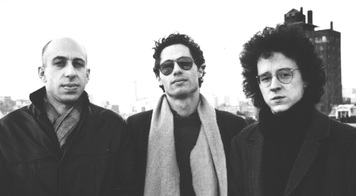
Semantics was formed by Samm along with saxophonist Ned Rothenberg and guitarist Elliott Sharp in 1985. They embodied a certain raw and aggressive sound that was characteristic of the East Village noise/rock scene, but tempered somewhat by Rothenberg's more jazzist stylings and all the member's backgrounds in exploratory and improvised music. In this group Samm was starting to mix acoustic drums with electronic drum pads, triggering samples, and Sharp was mixing electric guitar with sampling as well. The band played in NY, toured Europe and released two LP/CDs, the first being the eponymous Semantics, and the second titled Bone of Contention. As the New York Times's Jon Pareles put it, back in 1988, "the group stomps and clatters and squalls with a satisfying heft". That they did.
photo: Semantics, circa 1985, on East Village rooftop
photo: Semantics, circa 1985, on East Village rooftop
Third Person

Third Person was Samm's band with the late cellist Tom Cora. They were dedicated to free improvisation, but in a kind of "rhythm section" way: in fact, they were the rhythm section for an ever-changing third "member". Tom and Samm were the two permanent members of what was always a trio. Their invited guests (victims, as they generally referred to them) were continually changing, and over the course of the band's career they played with a great number of New York's finest improvisors: Marc Ribot, Zeena Parkins, George Cartwright, Thomas Chapin and Don Byron, to name but a few. Ultimately Japanese saxophonist Umezu Kazutoki became the official, steady third member of the band, however, and Third Person toured Japan with Umezu many times. They released two CDs. Sadly, Tom's untimely death in 1998 brought the band to an end, until the year 2012, when long-time member Umezu Kazutoki and Samm Bennett decided to reignite the project.
photo: Third Person in Japan, 1993
photo: Third Person in Japan, 1993
Chunk version 1
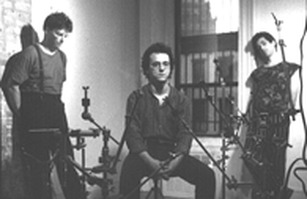
Chunk was the band Bennett formed in 1989 to serve as the vehicle for his song work, which was becoming his main focus by that point. The group started as a trio, with drummer Tim Spelios and percussionist/multi-instrumentalist David Simons. Samm's work with percussion-triggered electronics had evolved to the level where he was creating simple harmonic material on which to base songs, which was a key development in his musical pursuits. Covering the group's debut appearance at the Knitting Factory in 1989, the New York Times (once again, the indefatigable Jon Pareles!) wrote: "Chunk sets up intricate, off-center patterns ... Amid the rhythm, Mr. Bennett sings sustained, modal melodies in a country-tinged tenor, calmly unfolding quizzical observations and images of dislocation." As a trio Chunk played gigs in NY and toured Europe as well. The two original members appear on the first Chunk CD, Life of Crime, released in 1991, along with other members who joined the band later.
photo: the original Chunk (with Tim Spelios & David Simons, Brooklyn, 1989)
photo: the original Chunk (with Tim Spelios & David Simons, Brooklyn, 1989)
Chunk version 2
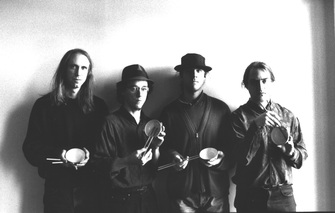
Chunk, 1994 - Mark Deffenbaugh, Billy Martin, Sebastian Steinberg
Samm soon wanted to take the band into a somewhat more mainstream direction, however, at least in terms of instrumentation. The songs he was writing were crying out for guitar and bass, and by the time the above-mentioned Life of Crime was released, the band had already evolved into a quartet more closely resembling a standard rock band. But for one difference: Samm was, in addition to singing, still triggering samples from drum trigger pads, and his sampled sounds still were a major part of the band's sonic character.
Over the next few years of Chunk's existence, many players came in and out of the band. On bass, there was first Jerome Harris (jazz legend Sonny Rollins's bass player for years), then Oren Bloedow (now of Elysian Fields), then Kato Hideki and Sebastian Steinberg (who went on to play bass for Soul Coughing). Mark "MadDog" Deffenbaugh (credited simply as "the Dog" on Life of Crime) was the mainstay guitarist, and drummers, after Tim Spelios, included Richard "Dickie" Dworkin (who had been Alex Chilton's drummer of choice for years) and Billy Martin (now of Medeski, Martin and Wood).
Over the next few years of Chunk's existence, many players came in and out of the band. On bass, there was first Jerome Harris (jazz legend Sonny Rollins's bass player for years), then Oren Bloedow (now of Elysian Fields), then Kato Hideki and Sebastian Steinberg (who went on to play bass for Soul Coughing). Mark "MadDog" Deffenbaugh (credited simply as "the Dog" on Life of Crime) was the mainstay guitarist, and drummers, after Tim Spelios, included Richard "Dickie" Dworkin (who had been Alex Chilton's drummer of choice for years) and Billy Martin (now of Medeski, Martin and Wood).
Chunk version 3
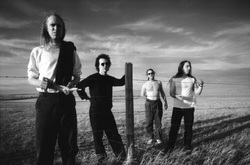
Chunk on tour: somewhere in North Dakota
In 1993 Bennett released his second collection of songs, The Big Off. Though it wasn't a Chunk album per se, most of the tunes featured rhythm section players that were either current or former members of Chunk, and many of the songs appearing on that release were being performed by the band at live shows. However, since the record featured many extra players who were not members, it wasn't exactly correct to call it a Chunk release. The record included instrumental contributions, for example, from Gary Lucas, Kazutoki Umezu, Dave Soldier, John Medeski, Curtis Fowlkes, Frank London, Annie Gosfield and many others, and was very much a studio project.
History of the Last Five Minutes
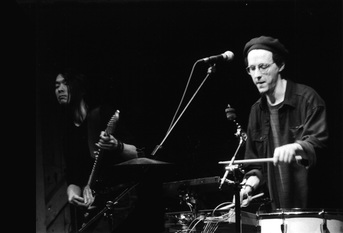
By 1995 Samm had disbanded Chunk, and his last song-related project in New York City was a duo with guitarist/violinist Hahn Rowe. Hahn had worked with Samm in Bosho, as well as off and on in other projects throughout Samm's tenure in NYC. They called the duo History of the Last Five Minutes. They recorded an eponymous album of Samm's songs in 1995, followed immediately by a European tour. They also played shows together in Japan and Israel. The duo was well-received, and probably would have continued in some fashion had it not been for Samm's decision to move on from New York. Tokyo was calling...
photo: History of the Last Five Minutes, live in Kobe, Japan 1995
photo: History of the Last Five Minutes, live in Kobe, Japan 1995
Tokyo, 1995-present
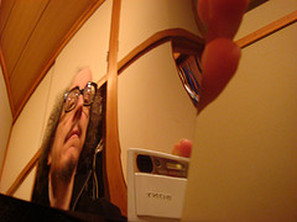
trying to stay flexible...
Samm was feeling the need to move on to new territory, and Tokyo, a city that he'd already visited about ten times on tours in Japan (once staying over a month to get a better feel for the place) seemed like the place to be. He had already met and worked with a number of different musicians based there, loved the ambiance and the food, and just had a generally good feeling about the place. So when Bennett married Haruna Ito (his partner in Skist) they decided to make their home there. Immediately upon arriving, Samm became involved in a number of different projects. He did a stint as guest member of Nakagawa Takashi's Soul Flower Union (on percussion and the occasional vocal) and co-produced (along with Cicala Muta leader Ohkuma Wataru) Nakagawa's solo release Soul-Cialist Escape / Lost Homeland. He began working with various creative musicians and improvisors such as percussionist Yoshigaki Yasuhiro, guitarist Uchihashi Kazuhisa and others. And he continued his working relationship with Kazutoki Umezu, who had brought him to Japan so many times for Third Person tours over the preceding years. Samm resumed his solo percussion performances, as well, and released a CD on the Improvised Music from Japan label called Secrets of Teaching Yourself Music, documenting some of his live concert work with various drums and percussion, electronic gadgets, toys and junk. He has also appeared as percussionist on some releases by avant-pop singer UA, and has done session work for other singers as well.
Skist
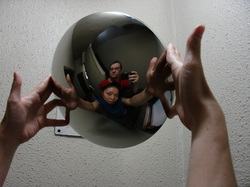
Skist gets reflective
Skist is the Tokyo-based project that Samm started with his wife Haruna Ito in 1997. Though not primarily a musician, Haruna's background as producer and manager for Otomo Yoshide's Ground Zero and other musical production endeavors had situated her firmly in the Tokyo avant-music scene, and she easily moved into the role of soundmaker and performer. She has a pure and very unaffected voice which is the perfect vehicle for delivering her dreamlike, poetic imagery, and which sits well with the spare. electroacoustic arrangements that characterize Skist music. Skist was very active for several years, gigging in Tokyo and elsewhere in Japan, and releasing two CDs on the Polarity label. Motherhood and other professional concerns have meant that Haruna has had far less time, in recent years, to focus on Skist, though, and these days they only very occasionally play live: they average about one or two shows in a year. Still, the project, though scaled back considerably, is continuing. For more on Skist, please see the Skist page at this website.
Quitting songwriting, then starting again
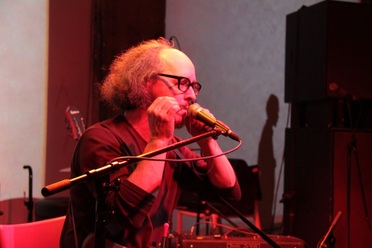
playing the Dan Moi, at Super Deluxe, Tokyo
One biographical point of interest is that for almost ten years, upon moving to Tokyo, Samm Bennett abandoned his singing and songwriting altogether. Perhaps it was being in a foreign land, and not being surrounded daily by the English language. Perhaps it was just a general lack of inspiration in that particular direction, coupled with a renewed desire to make instrumental music of various kinds. At any rate, the years 1995 to 2004 found Samm making only instrumental music. But, just as abruptly as he'd cut out singing and songwriting from his musical life, he then returned to it, with more interest and fervor than ever, in the year 2005. He began writing lyrics and songs again, and it seemed that a decade's worth of unexpressed ideas began to pour forth. Since this resumption, he has written hundreds of songs, and only a relatively small percentage of them have yet been recorded. But this aspect of his musical endeavor is most decidedly back, and being brought to fruition in solo as well as group performing situations. He is performing and recording more of his original songs than ever. For more details on his current projects, please see the following pages here at the Polarity Records website: